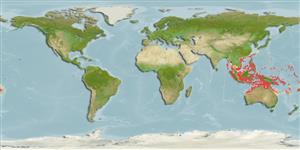>
Ovalentaria/misc (Various families in series Ovalentaria) >
Pomacentridae (Damselfishes) > Pomacentrinae
Etymology: Amblyglyphidodon: Greek, amblys = darkness + Greek, glyphis = carved + Greek, odous = teeth (Ref. 45335).
More on author: Cuvier.
Environment: milieu / climate zone / distribuzione batimetrica / distribution range
Ecologia
marino associati a barriera corallina; non migratori; distribuzione batimetrica 0 - 60 m (Ref. 128797), usually 12 - 45 m (Ref. 9710). Tropical; 30°N - 24°S, 90°E - 174°W
Western Pacific: Andaman Sea (Ref. 7247) and Christmas Island in the eastern Indian Ocean to Fiji, north to the Ryukyu Islands, south to Rowly Shoals (eastern Indian Ocean)and New Caledonia. Recently recorded from Tonga (Ref. 53797).
Size / Peso / Age
Maturità: Lm ? range ? - ? cm
Max length : 13.0 cm TL maschio/sesso non determinato; (Ref. 48636)
Short description
Chiavi di identificazione | Morfologia | Morfometria
Spine dorsali (totale) : 13; Raggi dorsali molli (totale) : 12 - 16; Spine anali: 2; Raggi anali molli: 14 - 15.
Body shape (shape guide): short and / or deep; Cross section: compressed.
Adults occur in steep outer reef, occasionally in deep lagoons and along channel walls, usually in current prone habitats and where there are abundant gorgonian and long sea-whip corals on which they lay and guard eggs. Juveniles in small groups often found among large sea fans or black corals. Feed on zooplankton (Ref. 7247). Oviparous, distinct pairing during breeding (Ref. 205). Eggs are demersal and adhere to the substrate (Ref. 205). Eggs laid usually on gorgonian dead branches (Ref. 90102). Males guard and aerate the eggs (Ref. 205).
Life cycle and mating behavior
Maturità | Riproduzione | Deposizione | Uova | Fecundity | Larve
Oviparous, distinct pairing during breeding (Ref. 205). Eggs are demersal and adhere to the substrate (Ref. 205). Males guard and aerate the eggs (Ref. 205).
Allen, G.R., 1991. Damselfishes of the world. Mergus Publishers, Melle, Germany. 271 p. (Ref. 7247)
IUCN Red List Status (Ref. 130435: Version 2025-1)
Threat to humans
Harmless
Human uses
Pesca: commerciale; Acquario: Commerciale
Strumenti
Special reports
Download XML
Fonti Internet
Estimates based on models
Preferred temperature (Fonte Biblio.
123201): 26.1 - 29, mean 28.1 °C (based on 904 cells).
Phylogenetic diversity index (Fonte Biblio.
82804): PD
50 = 0.5005 [Uniqueness, from 0.5 = low to 2.0 = high].
Bayesian length-weight: a=0.02344 (0.01134 - 0.04848), b=2.98 (2.80 - 3.16), in cm total length, based on LWR estimates for this (Sub)family-body shape (Ref.
93245).
Trophic level (Fonte Biblio.
69278): 2.7 ±0.30 se; based on food items.
Resilienza (Fonte Biblio.
120179): Alto, tempo minimo di raddoppiamento della popolazione meno di 15 mesi (Preliminary K or Fecundity.).
Fishing Vulnerability (Ref.
59153): Low vulnerability (10 of 100).
🛈
Nutrients (Ref.
124155): Calcium = 96.8 [48.8, 148.6] mg/100g; Iron = 0.72 [0.45, 1.17] mg/100g; Protein = 18.2 [17.0, 19.3] %; Omega3 = 0.116 [0.072, 0.185] g/100g; Selenium = 27.1 [15.4, 48.9] μg/100g; VitaminA = 81.4 [22.0, 272.3] μg/100g; Zinc = 1.64 [1.13, 2.35] mg/100g (wet weight);
